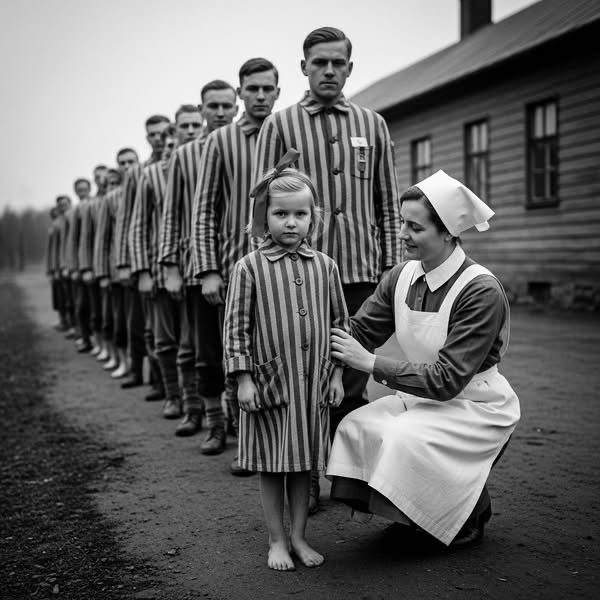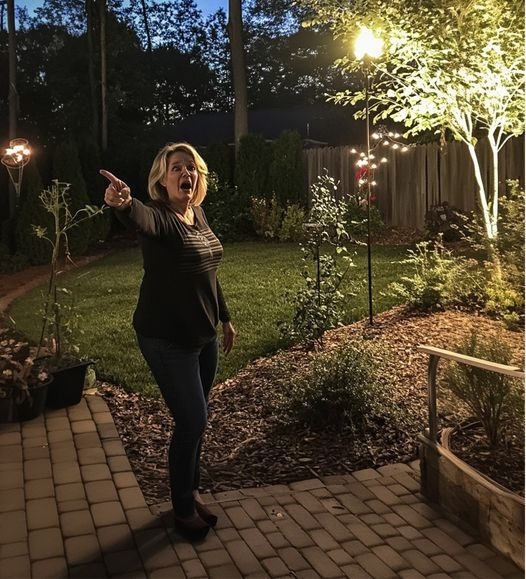As American forces stormed through the gates of the Dachau concentration camp in April 1945, the air was heavy with death, shock, and the faint sound of freedom.
The sight that greeted them left soldiers who had battled their way across Europe speechless: hundreds of skeleton survivors, their bodies scarcely shadows of life, their eyes vacant, their bodies wrapped in ragged striped uniforms.
One tiny figure stood out among the innumerable faces of sadness. It was a single, daring detail—a bright red ribbon wrapped precisely into her hair—rather than her strength or size.
Her age could not have exceeded six or seven years. She held the large hem of her concentration camp garment, her small feet barefoot on the chilly ground.
She remained silent as the soldiers came up to her and softly inquired her name. Her mouth quivered as her eyes dropped to the ground.
It seemed as though the barbed wire and the smoke that was still present had engulfed her entire identity, including her name, voice, and feeling of community.
However, she wore the same red ribbon in her hair each morning.
For her, it was everything, even if it was a simple deed that most others couldn’t see.
Nurses and medical professionals worked nonstop for days to provide the survivors with care. Slowly but gradually, the necessities of life returned: food, blankets, and medication.
However, the troops saw that the young girl said nothing. She ate in silence. Curled up along the wall, she slept. She would, however, reach into her pocket and knot the scarlet ribbon once again before the nurses arrived each morning.
Lieutenant Margaret Hayes, an American nurse, started to observe the custom. Hayes, an Illinois native with a gentle demeanor, had been caring for survivors day and night. She knelt next to the girl one morning while she knotted her ribbon.
She murmured softly, “Why do you keep that ribbon, sweetheart?”
For the first time since she had been saved, the youngster spoke as she raised her worn, sunken eyes.
“I remember that I am someone,”
Like sunlight piercing a storm, those five words broke the stillness. Nameless but not lost, this young girl had managed to hold onto her humanity with just a thread of scarlet in a place designed to erase faces, names, and hope.
THE NURSE WHO WAS IMPACTED
Survivors were transferred to shelters and orphanages around Europe once the camp was cleaned out at the conclusion of the war. The girl was moved to a Swiss children’s asylum while remaining silent and holding onto her ribbon.
Lieutenant Hayes made a self-promise to remember her before she went. She held the ribbon for a bit after carefully untying it from the girl’s hair.
She whispered, “I’ll keep this safe.” “Until you’re prepared to recall your identity.”
After giving a single nod, the girl vanished, joining the thousands of children who have been uprooted by the conflict. For years, Hayes searched for her but was never successful. She kept the ribbon in her medical bag, sandwiched between her notebook pages, for the remainder of her duty.
It was more than simply a memento to her. It served as a reminder that a spark of identity might endure even at the worst moments for humanity and a sign of defiance.
A GLASS CASE FROM A FIELD HOSPITAL TO A MUSEUM
Years went by. After returning to the US, Hayes got married and started working as a nurse in a small Boston hospital. She carried the red ribbon till her passing in 1968.
She included a note she had carefully scripted in her will, asking that it be donated to the US Holocaust Memorial Museum:
A little girl I met at Dachau owned this ribbon. To remind herself that she was someone, she knotted it daily. Please ensure that she is remembered by everyone.
In 1971, the donation was accepted by the museum. The ribbon, a little, fluttering bit of silk that had seen both human cruelty and the unbreakable resolve to live, was meticulously restored and set behind glass.
The plaque beneath it says:
“An unidentified child carried the Red Ribbon of Dachau.” A representation of resistance and remembrance.
People frequently spend more time there than anywhere else. Some people weep in private. Others remain silent as they consider how something so flimsy as a ribbon could bear the burden of identity, religion, and survival.
A tale that transcended the conflict
The girl may have survived, been adopted by a Swiss family, and subsequently immigrated to Canada, according to pieces of records discovered by historians decades later.
A photograph found in 1953 depicts a smiling woman with black hair and, definitely, a red ribbon knotted at her wrist, yet her name is still unknown.
Europe’s victory in World War II
Did she do it? Nobody knows for sure. Perhaps, though, that mystery adds to the story’s impact.
because more than one child is now the owner of the red ribbon. It is the property of everyone who has ever been told they are nothing and disbelieved them.
✨ A STRONGER THREAD THAN HATE
Even now, tourists still stop in front of the little exhibit at the Holocaust Museum in Washington, D.C. The delicate and fading ribbon lies beneath a gentle shaft of light, scarlet against the white fabric underneath.
Kids put their faces against the glass. Teachers define it. Survivors will occasionally pause and mutter a prayer.
It’s neither silver nor gold. It’s neither a flag nor a medal. It is a smaller but immensely more potent item.
A reminder that it takes bravery to be who you are.
A reminder that no matter what is taken away from you—your freedom, your family, your home—the resolve to declare, “I am someone,” will always remain intact.
SAINT MAXIMILIAN KOLBE, PRIEST AND MARTYR, THURSDAY OF THE NINETEENTH WEEK IN ORDINARY TIME (YEAR C.) (MEMORIAL). In 1894, Raymond Kolbe was born in Poland. When he became a Franciscan, he adopted the
FINAL COMMENTS
The major catastrophes of humanity are frequently depicted in historical records using numerical values: millions of people killed, thousands lost, and countless forgotten.
However, history can occasionally be found in the simplest objects, such as a ribbon, a diary, or a toy.
Even after being tied by shaking hands in the chilly Dachau wind, the girl’s scarlet ribbon endures.
It teaches us that remembering who we are—saying, “I am someone”—is the most potent kind of defiance, even in a world that is out to destroy us.


